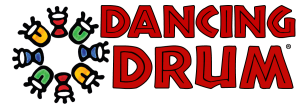DANCING DRUM FUNdamentals!
This program is designed for students to play, sing, dance, and read along from wherever they’re learning, whether at home or at school. Many of the lessons are self-explanatory, however, everyone can use a little extra help when learning how to play along with the Character Rhythms. This short introduction will give you all the tools you need to play every rhythm in this program!


We’ll use two special words throughout this program: BOOM and BA. These words represent the DRUM SOUNDS that we play on our instruments.



Each Character Rhythm can be played on a variety of Percussion Instruments or Found Sounds, whatever you have available. Some of the instruments that we recommend are:
1) HAND DRUMS
2) STICK DRUMS
3) DOUBLE BELL
4) BOOMBA Instruments
5) LAP-CLAP Body Percussion
Here’s how to make BOOM and BA sounds on each:
1) HAND DRUMS:
djembes, Tubanos, ashikos
2) STICK DRUMS:
buckets, djun-djuns, Tubanos with TubeStix
3) DOUBLE BELL:
The large bell makes a low tone and the small bell makes a high tone.
4) BoomBa Instruments:
BoomBa Instruments are color-coded RED and BLUE for BOOM and BA sounds.
A RED & BLUE TubeStix set can also play all of the music in this program! The RED tube makes the BOOM SOUND and the BLUE tube makes the BA SOUND.
5) LAP-CLAP Body Percussion:
If you don’t have an instrument to play, you can use your body!

Each of these ways to play makes a low sound and a high sound. You may use different instruments in your class or at home, and that’s fine!


We call unique, hand-picked percussion instruments “Found Sounds”. Things like cups, pans, water bottles, bowls, and kitchen containers can play BOOM and BA sounds, just like real drums! Explore your environment and experiment with different objects to find where they make low sounds and high sounds when played. Use your FOUND SOUNDS to make BOOM and BA rhythms!
For more about how to play along with Dancing Drum using Found Sounds, check out this video with Mr. Steve!


We can turn our rhythms into songs by adding a word or syllable to each BOOM and BA sound in the pattern. We call this RHYTHM PHONICS. Making a song out of a rhythm helps us remember where the drum sounds are supposed to go.
We can also write our Boom-Ba music with Rhythm Phonics BOX NOTATION, on an eighth or sixteenth note grid. Here’s an example that shows the Courage Rhythm, using a sixteenth note grid:

In the top row, we see a sixteenth note and the counting of one measure. The second row, marked W/S for Words & Syllables, contains the letters of the word “C-O-U-R-A-G-E” and then the 2 syllables of “Cour-age” at the end of the phrase. The third row, marked O/X, shows where the BOOM and BA sounds are played.
Another way to look at this rhythm is with color-coded STANDARD NOTATION. Here’s how one measure of the Courage Rhythm looks:

Notice that the notes of the rhythm are color coded red and blue for BOOM and BA sounds, and the placement of the notes on the measure is also LOW and HIGH.
You’ll see both of these music notation styles throughout the Character Rhythms and Character Rap+Rhythm lessons. If it seems complicated now, don’t worry. After you’ve watched the videos, it will all make perfect sense!










